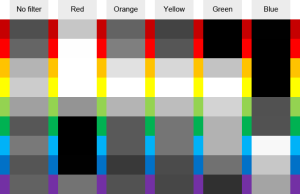Black and white filters we can use them to control how colours are converted to shades of grey. We use them when we need the exact contrast or mood . Usual issue in B&W photography is that some colours may look similar when converted into greyscale. We can definitely see it in certain shades of red, blue etc. which are completely different colours in coloured photography, however, black and white photography can make them look almost identical.
This causes objects in a black and white photography to look flat and lifeless, with a lack of any definition, interesting details and contrast.
That is why coloured lens filters have been invented. They affect the way colours are „converted“ to black and white. This allows you to control the way they appear in the final image, ensuring that objects are having enough of contrast and definition. Each colour filter has a different effect, so all of them are used in a different way. Coloured filters known to us are:
RED FILTERS
Red filters produce a very strong effect and highly increase contrast. They’re often considered too strong for most types of photography, but can be used to produce creative effects.
ORANGE FILTERS
Orange filters are something between yellow and red they give a nice balance of each one’s properties. They are considered to be multi-purpose.
YELLOW FILTERS
Yellow filter is the most gentle and subtle one. Sometimes the difference is minimal. They are commonly used among photographers who are just beginning, because they fit into almost every picture ‚just right‘.
GREEN FILTERS
Less popular, less used, but some use them in right circumstances.
BLUE FILTERS
Blue filter is not very used for black and white photography, because it tends to darken most of them and takes all the contrast.
Infrared PHOTOGRAPHY
Infrared Photography-is an unseen experience, because we literally cannot see IR light as it lies just beyond the “visible” spectrum, the one our eyes can detect.
When we take photographs using infrared-equipped film or cameras, we often see a very different world. Film is usually sensitive to visible light too, so an infrared-passing filter is used; this lets infrared light pass through to camera, but blocks most of the other spectrums-filters then look almost black or red.
When these filters are used together with infrared-sensitive film or sensors, „in-camera-effects“ can be obtained; false-colour or black-and-white images with something that might seem like a dream or lucid, we call it a ”Wood Effect,“ an effect mainly caused by foliage (such as tree leaves and grass) strongly reflecting in the same way visible light is reflected from snow.
This image shows how colours are converted to black and white with different filters:
Sources:
„Using Coloured Filters in Black&White Photography“ [http://www.photographymad.com/pages/view/using-coloured-filters-in-black-and-white-photography]: para. 1-12 [12 Jan 2016]
Vishneski, Bob. „Introduction to Infrared Photography.“ N.p., 12 Mar. 2012. Web. para. 1
[ https://photographylife.com/introduction-to-infrared-photography ] [12 Jan 2016]
(Just for some basic info) „Infrared Photography“:
[ https://en.wikipedia.org/wiki/Infrared_photography ] para. 1,2 [12 Jan 2016]

